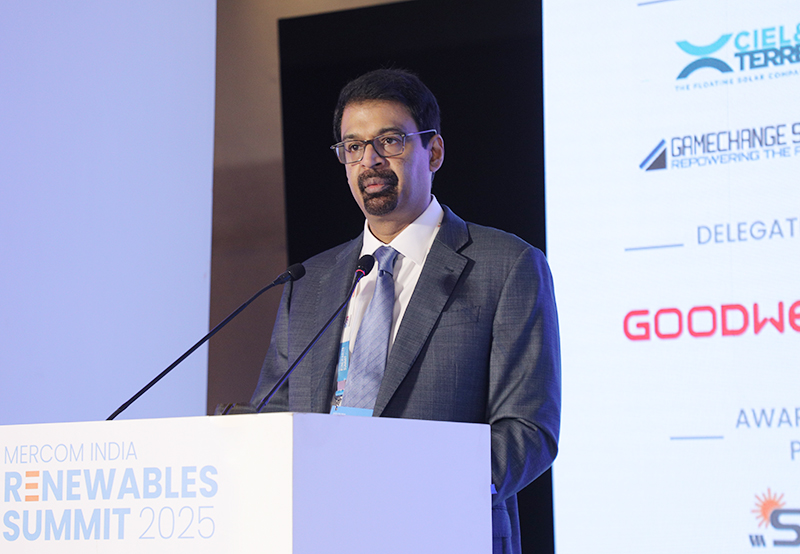India Must Urgently Set Post-2030 Renewable Energy Goals
Where Policy Met Ambition: Mercom India Renewables Summit 2025 Delivered Big
August 20, 2025
Follow Mercom India on WhatsApp for exclusive updates on clean energy news and insights
What an exceptional Mercom India Renewables Summit 2025 it was!
When we started covering India’s clean energy market, the entire country had just 6 MW of installed solar capacity. Today, we are talking in hundreds of gigawatts, and some of the “aggressive” targets once seen as unattainable have been met years ahead of schedule. That is why I am confident about the country’s 2030 goals. But here is the real challenge: 2030 is less than five years away, and the industry cannot thrive on short-term certainty alone.
Importance of Targets
To keep this momentum, we need a five to 10-year outlook. Targets give the industry direction. Without visibility beyond 2030, it is hard for investors to commit, for companies to expand manufacturing, or for developers to hire at scale. We need to build for the next decade, not just the next tender, which makes it imperative for the government to set ambitious post-2030 goals urgently.
The Opportunity
Globally, opportunity comes with risk. The U.S. has been one of the most lucrative export markets for modules, but its politics have shifted. The anti-dumping tariff list now includes India, along with Indonesia and Laos. India and the U.S. share a similar manufacturing mindset — “Make in India,” “Made in USA” — and that makes long-term export dependence risky. We should focus on the Indian market first. This is one of the largest, fastest-growing clean energy markets in the world. The Middle East and Africa may offer opportunities, but competition with China in those regions will be tough.
The Next Big Thing
The next big thing in India is energy storage. It is not just important, but essential to grid integration and stability. By contrast, offshore wind remains far too expensive for India right now, and hydrogen, while promising, is at least eight to 10 years away from being cost-competitive. Globally, most hydrogen projects are still in the pilot and demonstration stages.
However, waiting for prices to fall is not a correct strategy. That approach in solar cost us years of market leadership. We cannot afford to repeat the same mistake with storage. India must invest in research and development (R&D) and innovate now to lead the next wave of clean energy.
Area Requiring Attention
The skill gap is one of the most immediate issues. Today, it is slowing industry growth by 10% to 20%. The talent is here, but the training is not. Further, too many graduates are learning based on outdated technologies. The industry can train, but academic curricula must align with market realities, so we are not starting from scratch with every hire.
Impending Oversupply
Manufacturing expansion is exciting, but oversupply is a real risk if too many players enter without demand planning. We have seen it before in China; they built supply first, then scrambled to create demand. If that happens here, oversupply will put pressure on the government to intervene in the market. Over the long run, only companies that excel at quality, branding, and execution will stand apart from short-term opportunists.
Role of Investors
There is another aspect we do not discuss enough: the role of the financial sector. If we want to lead in clean energy manufacturing and technology, we need investors willing to take risks, to fund innovations like new battery chemistries, rather than just increasing capacity. Today, financing in India remains far more risk-averse than markets like the U.S., and that mindset needs to change.
The Bottom Line
India has the market size, ambition, and momentum to lead, but the work ahead is about more than just hitting targets. It is about planning past 2030, building resilience into manufacturing, closing the skills gap, committing to R&D, and executing at scale. If we can do that, we will not just meet our goals; we will define the global standard for what a clean energy transition can look like.
This year’s Summit left no doubt about where India’s renewable energy industry stands, and where it is headed.
I urge the government to focus its efforts on two critical initiatives that can move the sector into its next phase of growth.
First, policy stability and long-term visibility are non-negotiable. With 2030 less than five years away, the time for a clear post-2030 roadmap has come. Investors, manufacturers, and developers need to see five to ten years ahead to plan effectively, scale confidently, and allocate capital where it is needed most.
Second, skills will determine our speed. The training gap is slowing growth despite the existing talent. Industry, academia, and government must work together to align curricula with market needs and ensure a workforce ready to execute at the pace the transition demands.
Finally, the Summit gave the audience something rare: a clear, unfiltered view of the Indian renewable sector today and a realistic vision of the future. From market risks and export challenges to technology breakthroughs and manufacturing strategies, the conversations were candid, data-driven, and actionable.
In short, no other conference or forum offered such a direct line to what is happening on the ground and what is coming next. If the energy in the event was any indication, India’s clean energy ambitions are backed by an industry ready to deliver.
